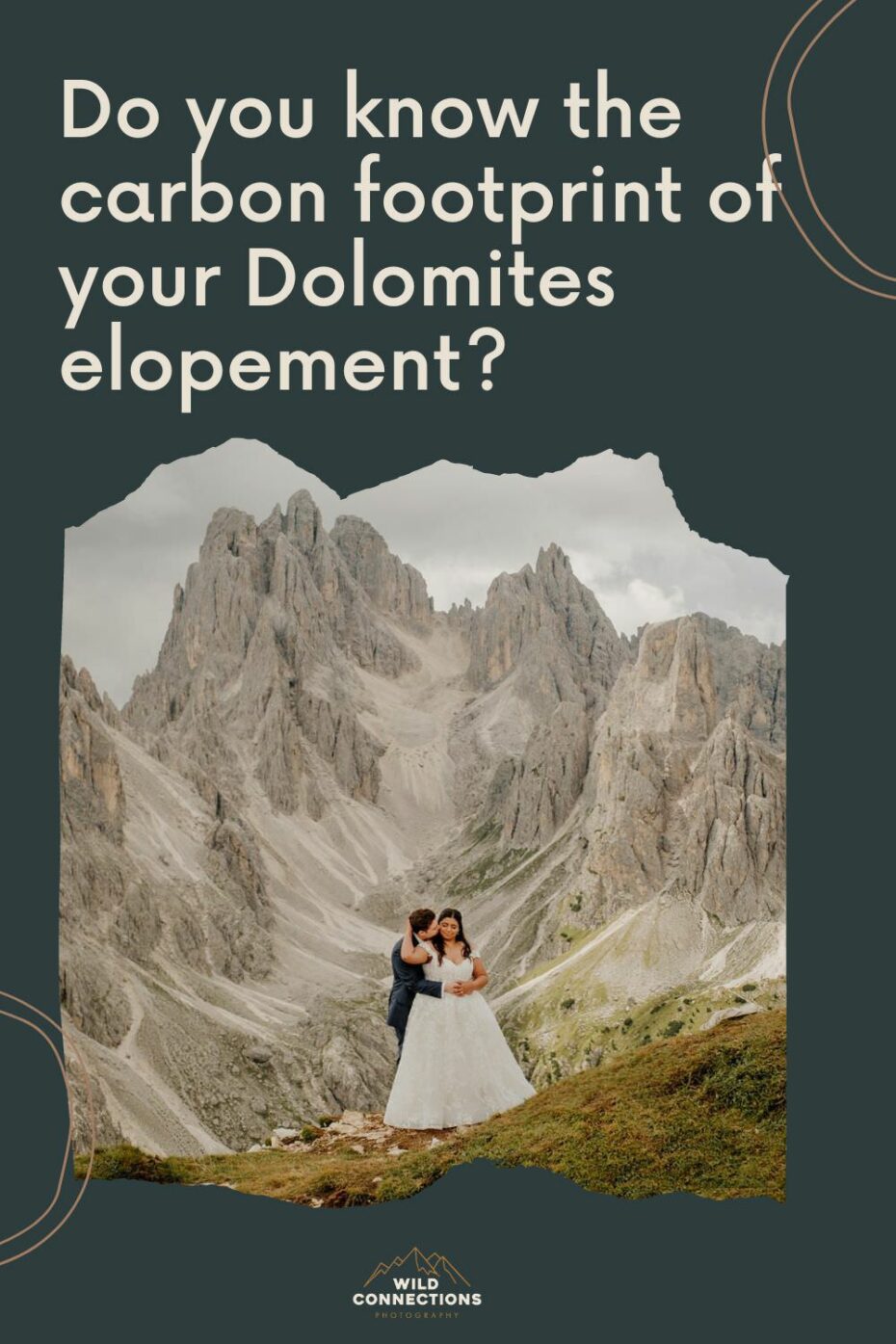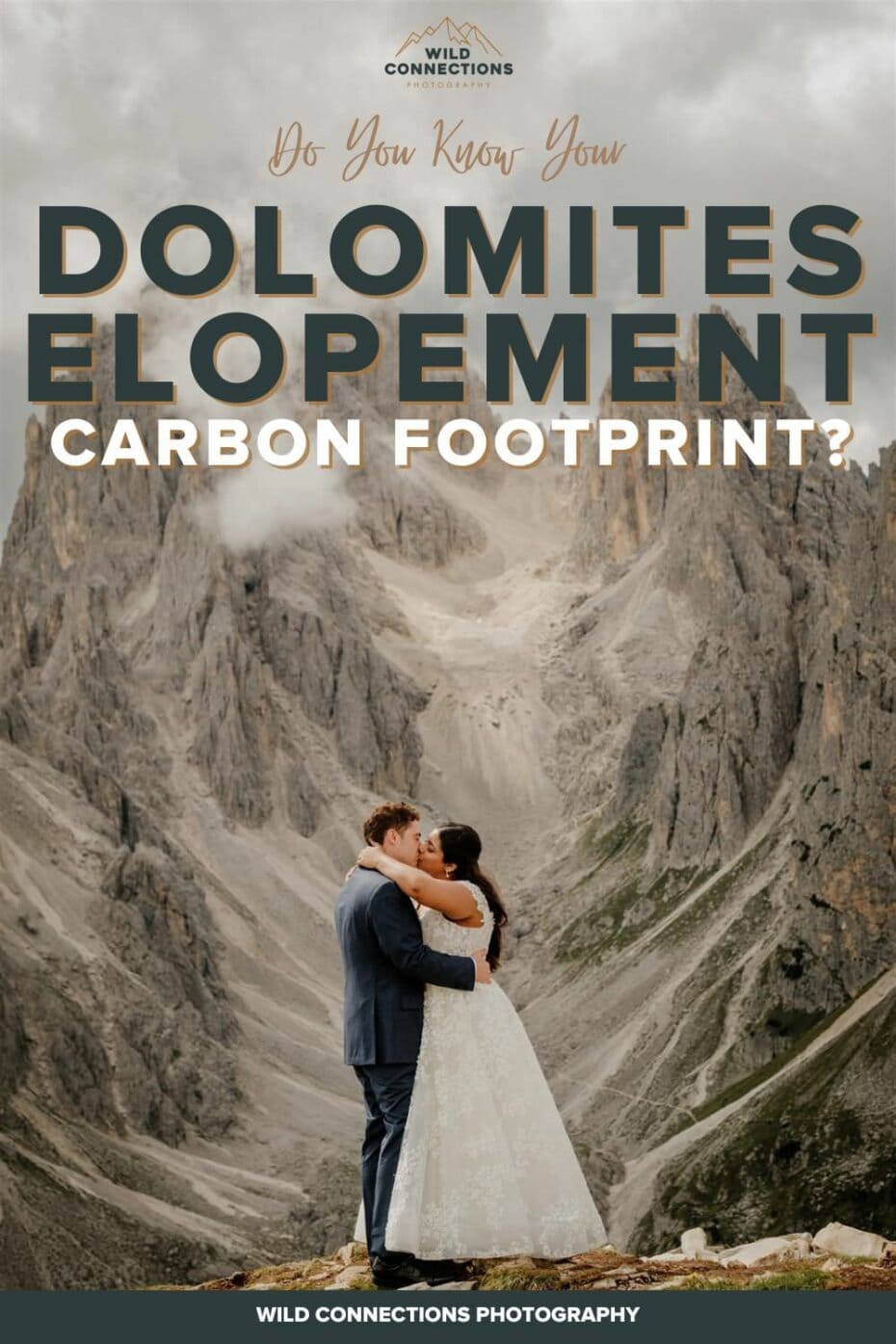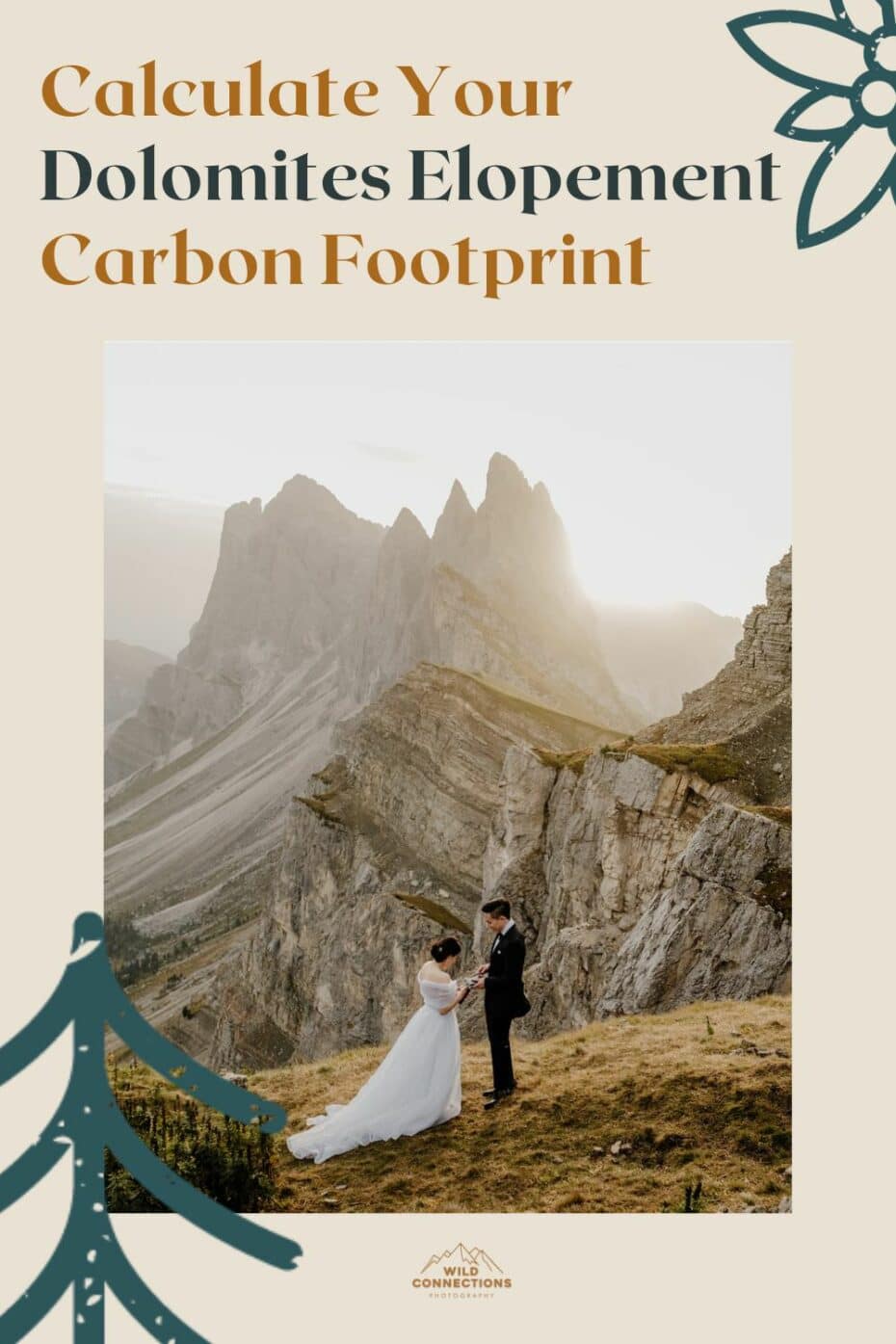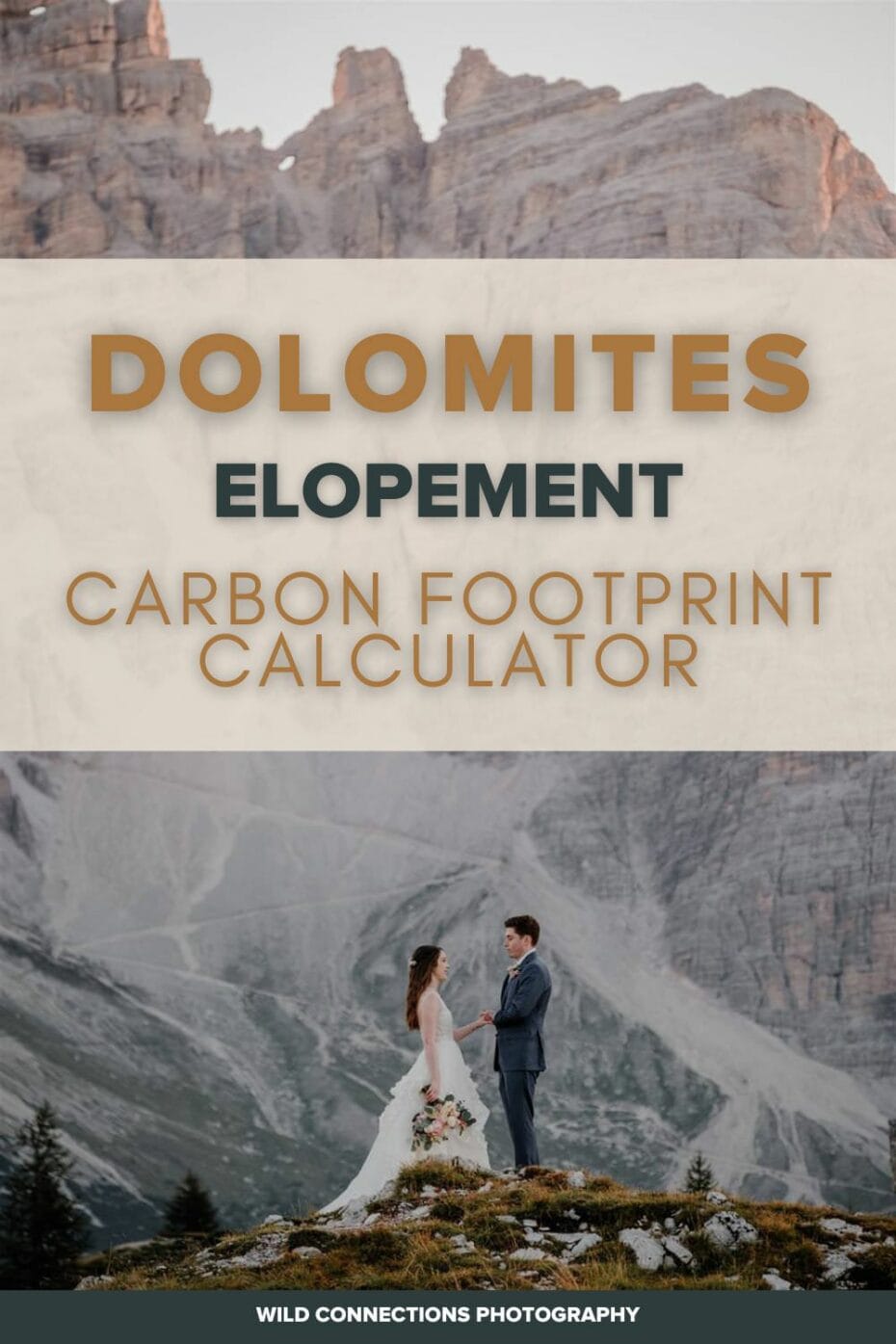Carbon Footprint of Your Dolomites Elopement
Disclaimer - Some posts on this website contain affiliate links. I may earn a small commission at no extra cost to you if you make a purchase using my links, which I'll almost certainly use to buy more skis and climbing gear.
As beautiful as can be, they can have a pretty big impact on our environment. But for many couples, that might be only one of the reasons why they might choose to celebrate the start of their marriage with a smaller celebration and choose to elope instead. Since I transitioned from shooting international destination weddings to only shooting elopements locally, I’ve thought a lot about whether an elopement really is the better option, and if so, how much better it is. And to take it further, are there particular choices that couples can make when planning an elopement in the Dolomites, to minimize that footprint even further?
Is Elopement the Greener Wedding Choice?
Whether it’s the grandeur of an all-out American wedding with hundreds of guests, or the intimacy of eloping in the magnificent Dolomites, the way we celebrate love can leave a lasting mark on the planet. But the question is, by how much? In this article, we’ll explore how these different styles of celebrating love can impact the environment, and what options you can consider when planning your elopement to reduce your carbon footprint.
notes on the Units and Context
- I’ve tried to focus my research on my area of expertise, which is elopements in the Dolomites, and the most common factors I experience related to planning an elopement in this area of the world. I’ve used the example of a couple from the USA traveling to Italy to elope, and have included the main elopement items that are commonly chosen by couples. While this may be a quite specific example, I hope that since calculations are given in context and with explanations, it will be relatively easy for couples to apply these to their elopement, wherever they are from, and wherever it may be taking place in the world.
- 1 ton/tonne refers to a metric ton, equivalent to 1000 kg
- CO2e refers to ‘carbon dioxide equivalent’, which is a way to measure and compare the impact of various greenhouse gases in terms of their contribution to global warming. It standardizes the assessment by converting gases like methane and nitrous oxide into the equivalent amount of carbon dioxide. This helps track and manage overall greenhouse gas emissions.
The Average Carbon Footprint Of A Wedding in the USA
As our planet continues to warm, an increasing number of individuals are recognizing the importance of monitoring their carbon footprint, quantified in terms of carbon dioxide equivalent (CO2e) emissions. With the pressing need to combat climate change, people are actively seeking ways to minimize their environmental impact, even during significant life events like weddings.
To put this into context, the average yearly carbon footprint of an American is approximately 16 tons of CO2e emissions, encompassing factors like food, transportation, and electricity consumption. To cap global warming at the Paris Agreement 1.5°C Paris Agreement, every person’s annual footprint needs to average 2.3 tonnes CO2e by 20301. However, a traditional wedding has the potential to produce a staggering 56.15 tons of CO2e emissions, which is over three times the annual consumption of the average American.
This significant environmental impact from weddings arises from various factors, with travel being the largest contributor. With traditional weddings, guests often travel from different parts of the country, often by air or long-distance car journeys, resulting in substantial emissions. Additionally, the choice of lodging and the energy-intensive wedding venue can add to the carbon footprint. Imported flowers too which are commonly used for elaborate decorations, contribute to emissions due to transportation over long distances.

Graph: Courtesy SAGE via Stanford Magazine2
The Footprint of An Elopement
More couples are choosing to elope, but it’s not just for the environmental benefits. Elopements also often offer a more cost-effective and convenient alternative to traditional weddings, making them an increasingly popular choice.
Beyond the financial savings, elopements also provide couples with a unique opportunity to create a deeply personal and intimate experience, free from the pressures and expectations of large gatherings. The reduced planning stress, combined with the chance to select a meaningful location, allows couples to truly focus on the essence of their union.
But how does an elopement hold up when you start to scrutinize its carbon footprint? Let’s break down the numbers:

Travel
For an elopement, travel to the elopement destination usually makes up the largest part of the footprint of the day. For many couples who elope in the Dolomites, the journey will involve a long-haul flight, and often a hire car, since public transport in the mountains can be somewhat inconvenient.
Air Travel
Air travel makes up the largest footprint of almost every elopement in the Dolomites. In the example below, I calculated the emissions for a return flight from New York (US), JFK to Venice (IT), VCE, where the flight distance is 6668 km3.
- Economy – 2 tons per person
- Premium economy – 3.2 tons per person
- Business class – 5.8 tons per person
- First class – 8 tons per person
Note on flight footprint calculators: For this article, I tested a few different flight calculators. For economy class, most calculators came in around the 2-ton mark for a return flight. Where they differed the most was the business and first-class calculations, where business class was calculated at various figures from 5.8 to 9.7 tons, and first-class from 8 to 12 tons. While there is quite significant differentiation in these numbers, what is clear is that the more space you take up on a plane, the higher your footprint is.
Why is the first-class footprint so much higher, since the plane is taking off anyway?
Flying first class generally has a larger carbon footprint compared to economy class on the same flight because the space occupied by a first-class seat takes up more room, resulting in fewer passengers per square footage of the plane. The fuel consumption per passenger is typically higher in first class because the overall weight of the plane is a significant factor in fuel efficiency. Since the fixed costs of operating the flight remain constant regardless of the number of passengers, having fewer passengers in first class means a higher proportion of the total emissions per passenger.
For a different long-haul flight, you can estimate a rough footprint by using these figures:
- Economy – 0.150 kg CO2e per passenger, per kilometer
- Premium – 0.240 kg CO2e per passenger, per kilometer
- Business – 0.434 kg CO2e per passenger, per kilometer
Calculate flight distance: Airport Distance Calculator
Road Travel
Once in Europe, most couples opt to hire a car for their Dolomites elopement. While public transport is improving a lot, for many it’s simply too inconvenient when planning the itinerary of their elopement, where often they will be starting before sunrise and visiting remote locations where public transport is infrequent.
Using the previous example of flying into Venice, we’re now driving to Cortina d’Ampezzo in the Dolomites, which is 150km one way. Once in the Dolomites, it’s very likely you’ll want to drive around and visit many of the popular sights, so driving around 500km during your trip is a reasonable estimate. So let’s take a look at the approximate emissions4 for driving around 500km:
- Average gasoline car – 0.134 kg CO2e per kilometer x 500km = 67 kg CO2e
- SUV gasoline car – 0.170 kg CO2e x 500km = 85 kg CO2e
- Compact gasoline car – 0.098 kg CO2e x 500km = 49 kg CO2e
- Electric car – 0.047 kg CO2e x 500km = 23.5 kg CO2e
- Hybrid car – 0.068 kg CO2e x 500km = 34 kg CO2e
Diesel vs Gasoline – Does It Matter?
I’ve asked myself this question a lot, since I own a small diesel car, and they are often villified in the media. In terms of their carbon footprints alone, there is very little difference between diesel and gasoline5. Diesel cars actually tend to produce slightly less carbon emissions than their gasoline equivalents (around 200g CO₂/km for petrol and 120g CO₂/km for diesel), however, with diesel engines, one of the biggest problems are the toxic emissions of nitrogen oxides (NOₓ)6.

Vendor Travel
Within the carbon travel budget of the elopement, it’s important not to overlook the travel of all of the vendors associated with the elopement too. This might include vendors such as:
- Photographer
- Videographer
- Hair & Makeup Artist
- Private Chef
- Elopement Planner/Co-Ordinator
- Officiant/Celebrant
For almost any vendor chosen, most will travel to your elopement by car. The closer they live to your elopement destination, naturally means the shorter the distance they will need to travel and the fewer related emissions. If any vendors are flying in from overseas, the emissions will naturally be higher due to air travel, regardless of the type of car used.
The mountain backdrops of the Dolomites are what draws couples to elope in this region. However, for many couples, there is a desire for ‘convenient’ access to remote mountainous locations, without the need for lengthy hikes. To fulfill this desire, cable cars and helicopters have emerged as popular choices for transportation.
Cable Cars/Ski Lifts
Cable cars offer a budget and eco-friendly option to get high into the mountains, emitting approximately 0.044 kg CO2e per passenger for each kilometer traveled.7
Helicopter Flights
Helicopters, on the other hand, provide the desired privacy but tend to have a higher carbon footprint, generating around 500 kg CO2e per hour8. It’s important to note that helicopter flights, aside from the increased emissions, can also be quite noisy, potentially affecting the serene ambiance of these natural settings.
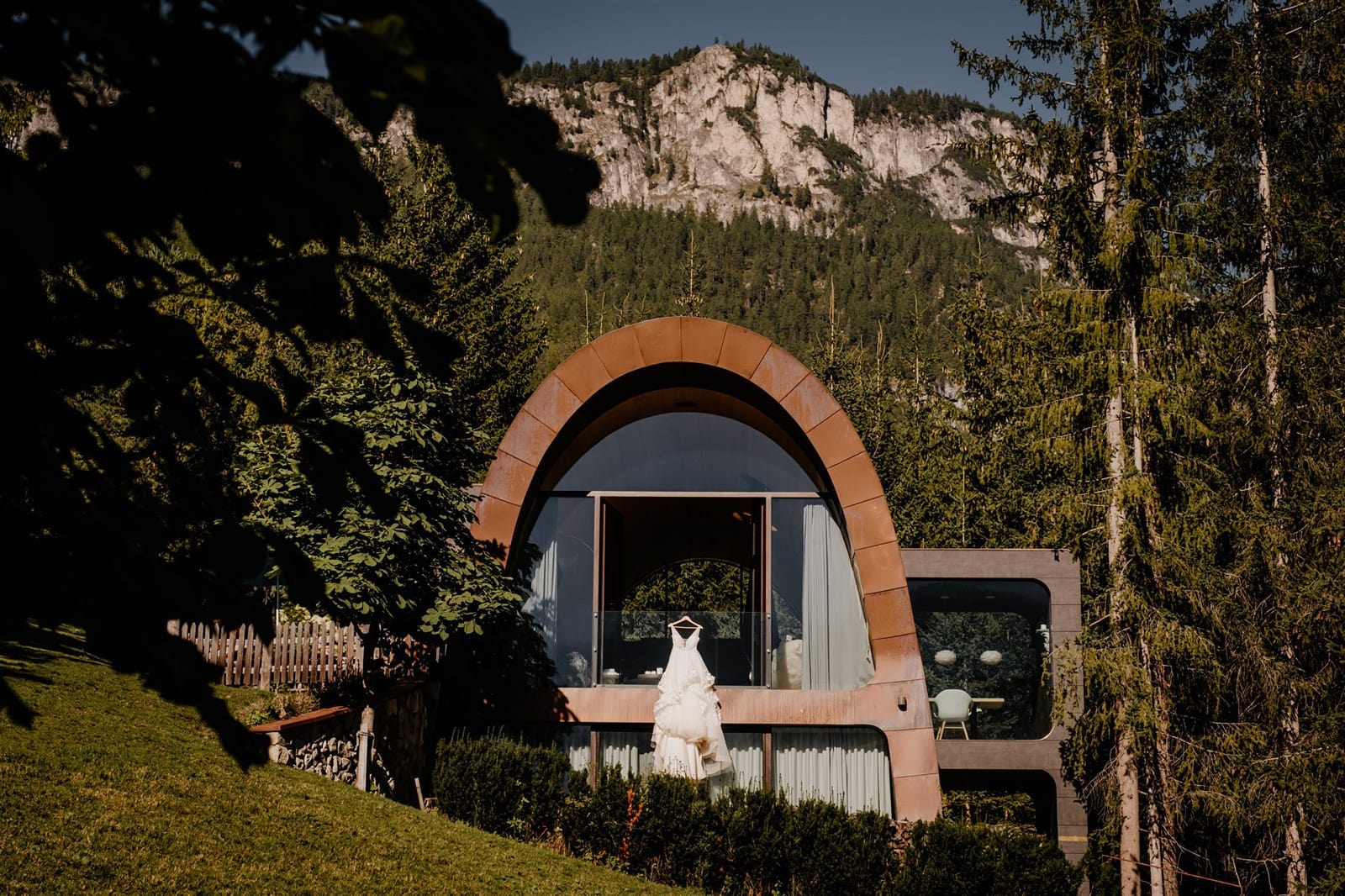
Accommodation
In Italy, the average carbon footprint for accommodations is approximately 14 kg CO2e per room, per night9. However, for many couples when planning an elopement, there’s a chance you’re considering something a little more than average for this special occasion. While calculating the exact footprint of your hotel stay can be difficult, since every hotel is different, there are some factors that will increase or decrease the footprint of your stay.
A one-night stay in a luxury hotel, where food is imported, the outdoor pool is heated even in winter, the heating is so high you need to open a window, you go through multiple towels and a bathrobe in one night, and breakfast is a large buffet of all kinds of items, many of which are not local or seasonal, and what’s not eaten is thrown out. These are just some of the things that make the footprint of your hotel stay increase.
To reduce the footprint of your accommodation, you can look for hotels with eco-credentials. These might include hotels or apartments that:
- Use renewable energy sources, take steps to reduce energy usage & have energy-efficient buildings
- Encourage responsible water consumption
- Take waste disposal seriously, and prioritize waste reduction and recycling
- Support sustainable travel, such as having electric car chargers, bike rentals or free public transport passes
- Food choices – prioritize locally sourced ingredients and meat-free options and take steps to reduce food waste by having service over a buffet
- Promote sustainable recreation activities
Wedding day Food
After a day in the mountains, most couples are hungry for a great dinner to end their day. But here’s how your menu choice might affect your carbon footprint:
- Vegan meal – 0.963 kg CO2e
- Vegetarian meal – 1.271 kg CO2e
- Meat option – 2.636 kg CO2e10
- Bottle of Prosecco – 1.6 kg CO2e11

Wedding Outfits
While specific emissions data for wedding attire may not be readily available, we can draw parallels from emissions associated with everyday clothing materials. For instance, the production of traditional cotton garments like t-shirts emit approximately 8.4 kg CO2e, while polyester emits 7.2 kg CO2e12, and viscose emits 6.7 kg CO2e. Opting for recycled alternatives can lead to lower emissions, with recycled cotton at 5.6 kg CO2e, recycled polyester at 6.5 kg CO2e, and recycled viscose at 6.4 kg CO2e.
It can be estimated that a wedding dress typically carries an environmental footprint ranging from 10 to 20 kg CO2e (depending on the materials and methods used in its creation)13, and new tuxedo jacket can contribute approximately 43.5 kg CO2e.14
Some couples are also tempted by cheaper, fast-fashion retailers for their elopement attire, since they only plan on wearing it once, and know it’s likely to get dirty. But fast fashion comes with an even higher footprint, due to the fact it produces clothing in excess, and much of it ends up in landfill or being burned. And that’s not taking into account the human rights abuses that often go alongside it too.
No matter what the item of clothing, anything that is being made new will have a footprint. So why not choose to reduce your footprint and opt for the more sustainable choice of either buying something pre-loved, renting, or wearing something you already own.
>> Related Reading – Sustainable Wedding Fashion

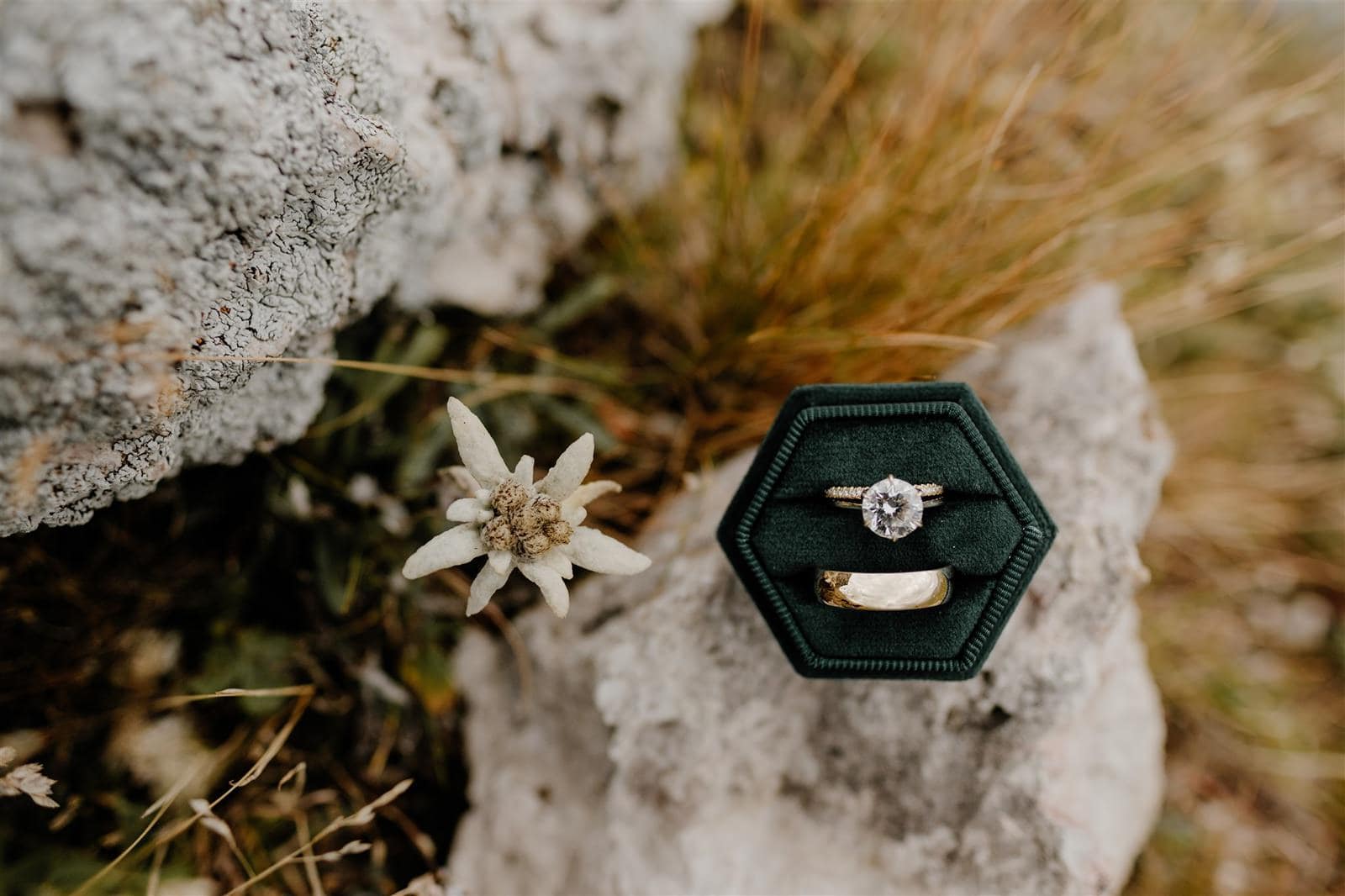
Rings & Other Jewelry
When it comes to engagement and wedding rings, and other jewelry items, luxury and sustainability can co-exist.
For those looking to minimize their carbon footprint, wearing a vintage or passed-down ring stands not only as the most environmentally friendly choice but also a sentimental one especially if it comes from a loved one whose love is an inspirational force for your own relationship.
Metals
The table below shows a comparisson between different metals, and the difference between new and recycled metals:15
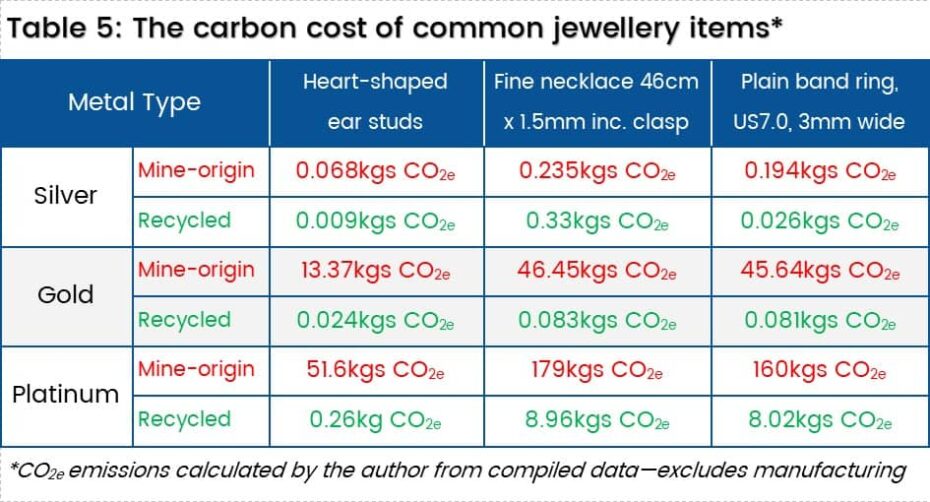
Diamonds – Mined vs Lab-Grown
When it comes to diamonds, the main discussion when it comes to carbon footprints is the debate on whether mined or lab-grown diamonds are more sustainable. However, if we’re looking solely at the issue of carbon footprints, due to a lack of transparency in the industry, it’s difficult to get any reliable data.
One report in 2014 by consultancy firm Frost & Sullivan calculated mined diamonds at 57 kgs of CO2 per carat, and lab-grown at just 0.028 grams16, while another report by S & P Global TruCost in 2019 calculated that 160 kgs of CO2 are emitted per polished carat of mined diamonds compared to 511 kgs of CO2 for an equivalent lab-grown diamond.17 One of the biggest arguments for the significant difference in the footprint of lab-grown diamonds is the assumption of use of renewable energy in the Frost & Sullivan report.18
However, as with many of the other things we’ve covered in this article, the carbon footprint alone may not be the reason to choose lab-grown diamonds over mined. The myriad of other ethical and environmental issues associated with mining is something that many couples simply can’t overlook.
And then there’s the most sustainable way of all. You guessed it – vintage, heirloom or pre-owned diamonds. Whether you choose to have them re-set to fit your style, or you keep them exactly as they are, that’s an individual choice. But using a diamond (or any other precious gemstone) that’s already in the world is the most sustainable option.

Flowers
A floral bouquet can range dramatically in footprint, mostly linked to where and how they are grown.
A small bouquet picked from your garden and grown only using organic fertilizer has as good as no carbon footprint. But if you’re having a destination elopement in the Dolomites, this is probably not going to be an option. You might be lucky to be staying somewhere that has a garden and would allow you to pick flowers from it, but for most people, this option is unlikely. And if you’re also looking to follow Leave No Trace, then picking wildflowers is also not something you should be doing. So what are the alternatives?
- A small bouquet of 15 stems of outdoor, locally grown flowers has a footprint of around 1.7 kg CO2e.
- A bouquet of 5 roses, 5 lilies & 3 baby’s breath, grown in hothouses & airfreighted comes in around 32.3 kg CO2e.19
- A faux flower bouquet, made from oil-based plastics, polyester fabric, and latex comes in around 29.1 kg CO2e.20
These numbers show that organic, locally grown, and in-season flowers are the best option if you want to have flowers for your elopement. They can also have the additional benefit of benefiting bees and other pollinators when grown on a small scale amongst other flowers.
With many imported flowers, the high footprint isn’t only attributed to the many miles they have traveled, but it can also be linked to how they are grown. Roses, for example, are often grown in Africa. However, roses are also grown in heated greenhouses (known as ‘hothouses’) in Europe. While European roses may have traveled fewer miles than those from Africa, their footprint is actually pretty similar since to imported roses, as hothouses are very energy-intensive. These commercially grown flowers are also often grown as mono-crops, which can degrade soil quality and increase the need for industrial fertilizers.
While faux flowers may have a higher carbon footprint, they can be reused for multiple occasions, potentially mitigating their environmental impact over time. Additionally, their ability to be stored for extended periods means they require less transport emissions compared to fresh flowers, which often necessitate immediate transportation to maintain their freshness. However, if they are only used once, then they no longer become a more sustainable alternative.

Does A Dolomites Elopement Have a Smaller Carbon Footprint?
The Comparison
| Item | More Sustainable Choices | Upscaled Choices |
| Travel | 4000 kg CO2e (Return flights – Economy Class) 23.5 kg CO2e (electric for 500km – car) | 11,600 kg CO2e (Return flights – Business Class) 85 kg CO2e (SUV for 500 km – car) |
| Accomm. | 15 kg CO2e (average – 1 night) | 26.6 kg CO2e (upscale – 1 night) |
| Dinner | 1.271 kg CO2e (Partner 1 – vegetarian) 0.963 kg CO2e (Partner 2 – vegan) 1.6 kg CO2e (wine) | 2.636 kg CO2e (Partner 1 – meat) 2.636 kg CO2e (Partner 2 – meat) 1.6 kg CO2e (wine) |
| Outfit | 0 kg CCO2e (pre-owned gown) 0 kg CO2e (rented tuxedo) | 20 kg CO2e (higher range wedding gown) 43.5 kg CO2e (new tuxedo jacket) |
| Rings | 0.081 kg CO2e (recycled plain gold ring) 0 kg CO2e (vintage one-carat diamond gold ring) | 45.64 kg CO2e (new plain gold ring) 111 kg CO2e (new one-carat diamond gold ring) |
| Flowers | 1.7 kg CO2e (fresh, local & seasonal) | 32.3 kg CO2e (fresh, imported) |
| Transport | 0.176 kg CO2e (cable car) | 500 kg CO2e (60 mins heli ride) |
| Vendors | 11.76 kg CO2e (local photographer within 100 km – compact car) 11.76 kg CO2e (local make-up artist within 100 km – compact car) | 2000 kg CO2e (photographer- flown in from USA – plane economy) 11.76 kg CO2e (local make-up artist within 100 km – compact car) |
| Total | 4067.811 kg CO2e (4.068 tons CO2e) | 14,482.672 kg CO2e (14.483 tons CO2e) |
Conclusion
In an age where sustainability is more than just a buzzword, and increasining numbers of couples are considering their choices, elopements emerge as a viable eco-conscious alternative.
In comparison to an average wedding in the USA, with its 56.15 ton CO2e footprint, a luxury elopement in the Dolomites would bring that down your carbon footprint by almost three-quarters, to 14.48 tons, and an elopement with even more sustainable considerations could be as low as 4.068 tons CO2e, with the majority of the footprint coming from the flights to/from Italy.
As more couples prioritize sustainability and environmental responsibility, elopements continue to shine as a greener way to celebrate your love, and the Dolomites are one of the most incredible places to do it. They stand as a testament that you can celebrate your love in a profound and truly memorable way, without it making such a negative impact on our planet.
References
- United Nations Environmental Programme. 2023. Emissions Gap Report 2023 https://www.unep.org/resources/emissions-gap-report-2023 ↩︎
- Stanford Magazine. (2017). Greening the Wedding. https://stanfordmag.org/contents/greening-the-wedding ↩︎
- Airport Distance Calculator. (n.d.). JFK to VCE. Airport Distance Calculator. https://www.airportdistancecalculator.com/flight-jfk-to-vce.html ↩︎
- Statista. (2022). Car CO2 Emissions by Size & Type. Statista. https://www.statista.com/chart/27253/car-co2-emissions-by-size-type-statista-mmo/ ↩︎
- Our World in Data. (2023). Which form of transport has the smallest carbon footprint? https://ourworldindata.org/travel-carbon-footprint ↩︎
- The Conversation. (2017) Fact Check: are diesel cars really more polluting than petrol cars? https://theconversation.com/fact-check-are-diesel-cars-really-more-polluting-than-petrol-cars-76241 ↩︎
- Si Magazin. (2019). CO2 und Lärm: Seilbahnen besitzen die beste Energie- und Ökobilanz. Si Magazin. https://www.simagazin.com/en/si-urban-en/topics-urban/urban/co2-und-laerm-seilbahnen-besitzen-die-beste-energie-und-oekobilanz/ ↩︎
- Railway News. (2022). How Green Is Satellite Monitoring? Let’s Do the Math. Railway News. https://railway-news.com/how-green-is-satellite-monitoring-lets-do-the-math/ ↩︎
- Circular Ecology. (2023). The Carbon Emissions of Staying in a Hotel. Circular Ecology. https://circularecology.com/news/the-carbon-emissions-of-staying-in-a-hotel ↩︎
- PETA. (n.d.). Fight the Climate Crisis. PETA. https://www.peta.org/issues/animals-used-for-food/fight-the-climate-crisis ↩︎
- Tsalidis, G. A., Kryona, Z. P., & Tsirliganis, N. (2022). Selecting south European wine based on carbon footprint. Resources, Environment and Sustainability, 9, 100066. ↩︎
- 8 Billion Trees. (2023). Carbon Footprint of Polyester. 8 Billion Trees. https://8billiontrees.com/carbon-offsets-credits/carbon-footprint-of-polyester/ ↩︎
- Something Old Something New. (n.d.). About Us. Something Old Something New Sustainable Bride Wear.. https://www.somethingoldsomethingnewsustainablebridalwear.com/about-us ↩︎
- M.J. Bale. (n.d.). Saunders Stretch Tuxedo Jacket (Black). M.J. Bale. https://www.mjbale.com/products/saunders-stretch-tuxedo-jacket-black ↩︎
- Ethical Jewels. (2019). What’s the Carbon Cost of Your Jewellery? Ethical Jewels. https://www.ethicaljewels.com.au/2019/05/10/whats-the-carbon-cost-of-your-jewellery/ ↩︎
- Frost & Sullivan. (2014). ENVIRONMENTAL IMPACT ANALYSIS PRODUCTION OF ROUGH DIAMONDS. https://cdn.shopify.com/s/files/1/1164/4258/files/Rough_Diamond_version_28-11-14v2_1.pdf ↩︎
- The Jewellery Editor. (2019). Lab-grown diamond’s carbon emission greater than naturals. https://www.thejewelleryeditor.com/jewellery/article/report-reveals-lab-grown-diamonds-high-carbon-footprint-eco-diamonds/ ↩︎
- Constable, H. (2020). BBC Future. The sparkling rise of the lab grown diamond. https://www.bbc.com/future/article/20200207-the-sparkling-rise-of-the-lab-grown-diamond ↩︎
- Berners-Lee, M. (2022). The Carbon Footprint of Everything. A bunch of flowers. p.89-91. https://www.amazon.com/Carbon-Footprint-Everything-Mike-Berners-Lee/dp/1771645768?encoding=UTF8&returnFromLogin=1&linkCode=ll1&tag=wildconnectio-20&linkId=776c0b19e09b896b2d1c1c307f8e3f99&language=en_US&ref=as_li_ss_tl ↩︎
- Silk Stem Collective. (n.d.). Eco-Friendly Wedding Flowers: A Carbon Footprint Study. Silk Stem Collective. https://silkstemcollective.com/eco-friendly-wedding-flowers-carbon-footprint-study/ ↩︎


